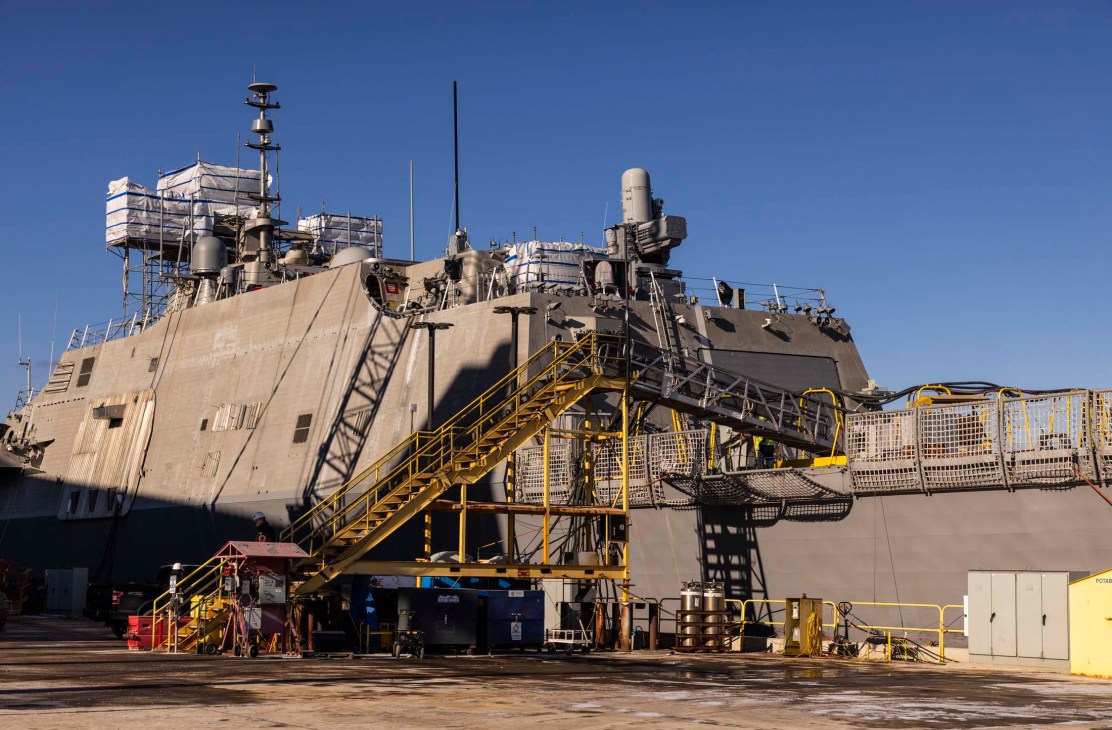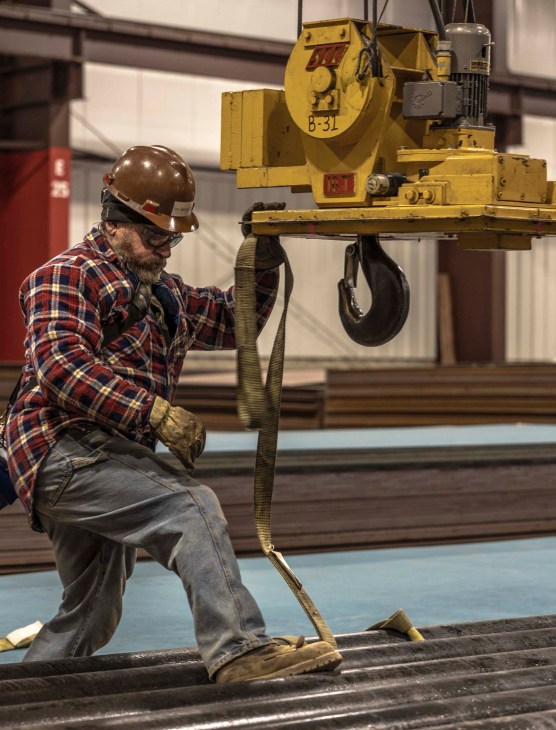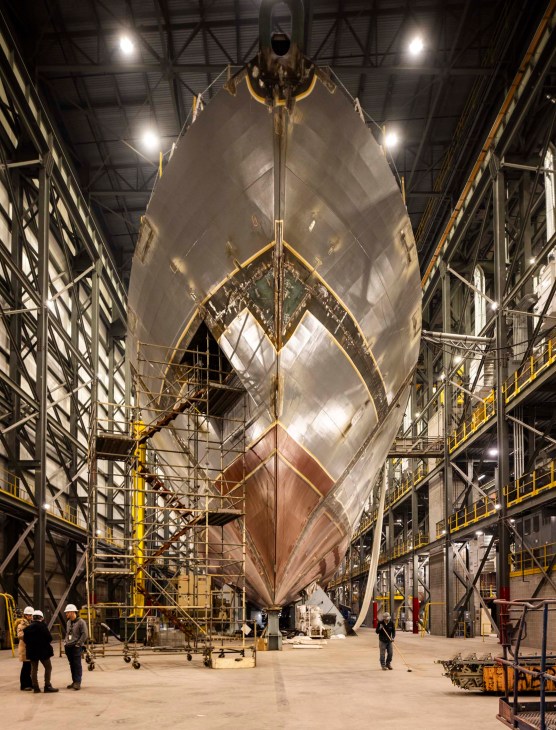Turning the tide: The shipbuilding company reviving a small Midwest town
Italian-owned Fincantieri is tapping into the US naval shipbuilding market – and breathing life back into Wisconsin in its slipstream.
Wisconsinites are well accustomed to harsh winters but the deep freeze that descends upon the northern part of the Midwestern US in the first months of the year can test even the hardiest. When the temperature dips to minus 34C, schools close and workplaces shutter. Yet in tiny Marinette, a town on the icy shores of Lake Michigan, some 2,000 welders, fitters and engineers report for work as usual to build the next generation of American warships.
Founded in 1942 to bolster the US Navy’s war effort, today the Marinette yard is helmed by Italy’s state-owned shipbuilders Fincantieri, which acquired this frozen outpost in 2009. It’s a far cry from Fincantieri HQ in Trieste, which launches ships into the much more clement Adriatic Sea, but it has caught the changing tide of a once-dying American industry and is investing in the Rust Belt.
Fincantieri is the largest shipbuilder in Europe and owns an integrated network of yards from Genoa to Palermo, which churn out cruise ships, submarines, off-shore wind-support vessels and luxury yachts. Over the past 20 years, however, it has expanded its reach across four continents with 18 shipyards. In 2009 the firm’s CEO Giuseppe Bono, eager to break into the market of Nato’s largest naval power, spotted an opportunity that larger US shipbuilders had overlooked: a somewhat forlorn outpost on Wisconsin’s Great Lakes, which had access to the Atlantic Ocean and several modest contracts with the US Navy. Fincantieri acquired Marinette Marine that year, along with another shipyard 35km across the water in Sturgeon Bay, for $120m (€115.6m). Since then, the firm has invested $400m (€369m) in new facilities and infrastructure, with climate-control systems that keep the assembly lines at 15C even in the dead of winter.

“We’ve never lost a day due to bad weather,” says Marco Galbiati, CEO of Fincantieri Marine Group, the firm’s US subsidiary. In tailored houndstooth trousers, black loafers and white dress shirt, the Italian executive sticks out among his fleece-clad Midwest counterparts. Nevertheless, he is at home in the shipyard and is proud to give Monocle a tour of the expanding facility. In a hangar-sized building, we watch as hunks of steel are cut and welded onto a gargantuan hull destined for a ship in Saudi Arabia’s naval fleet. Then we are ushered into an even more cavernous space completed last year to accommodate Fincantieri’s mammoth new project: the construction of the US Navy’s first Constellation-class guided-missile frigate, the skeleton of which is taking shape before our eyes.
Galbiati, who worked his way up Fincantieri’s corporate ladder in Italy before moving to Washington, makes regular visits to Wisconsin to ensure that the company’s trademark “system of yards” process of shipbuilding is working smoothly. “The idea of ‘system of yards’ is about flexibility and to smooth out the peaks and valleys of shipbuilding production,” says Galbiati. In practice, this means that a facility in Sturgeon Bay cranks out ships’ bows while a purpose-built aluminium construction plant in Green Bay fabricates the superstructure. These modules are then shipped by barge to Marinette, where they are welded together into a hull.
This multi-site production process happens in the same way whether it’s at the Great Lakes or between Fincantieri’s cruise ship-manufacturing shipyards on the Adriatic. It’s what has turned the storied company into a true global powerhouse – and a potential saviour of US shipbuilding as it attempts to recapture its glory days. “We build for customers who need complicated ships that require skilled workforces,” says Mark Vandroff, the outgoing CEO of Fincantieri Marinette Marine, which operates the shipyard. The only type of seaworthy vessel that Fincantieri doesn’t make, he explains, is container ships. “We don’t build boxes to haul boxes.”

Shipbuilding was once a symbol of American industrial might. During the Second World War, the US built aircraft carriers in a matter of months. Today a new carrier takes eight years. But from its lowest point in the 1980s, when some 40,000 production jobs disappeared, shipbuilding is now a rare subject of bipartisan agreement in Washington. The Navy’s $1trn (€962bn) procurement plan calls for more than 100 new vessels over the next 30 years, and production is expected to peak in the next decade. This presents a lot of potential work for a dwindling number of active shipyards.
From Saab to Hyundai, foreign firms have been lining up to enter the world’s biggest defence market. But getting on the Pentagon’s books is notoriously difficult, especially in an industry dominated by large, historic US players. Wisconsin might be out of the way, with ports that freeze over for three months of the year, but the Marinette shipyard has allowed Fincantieri to get a firm foothold in the US market. All of this makes it well-positioned to tap into a lucrative revival of the industry.
When it took over the shipyard in 2009, Fincantieri inherited a contract to build 16 nimble, multipurpose craft for the Navy’s littoral combat ship (LCS) programme. While the LCS was ultimately a choppy project, it required Fincantieri to hire 1,000 people in the US, and proved to the Navy that it could build at scale. This helped Fincantieri land a bonanza deal to build 10 frigates worth $5.5bn (€5.3bn) in 2020 and has ensured steady work for decades to come. It will need to recruit another 500 workers over the next two years to ramp up the construction efforts that have re-energised this Rust Belt town. “In this area, either you work here, your family works here or your best friend works here,” says Fincantieri’s Bethany Skorik, a Marinette local.

Today the shipyard looks very different from when Fincantieri took over. The company is bringing state-of-the-art shipbuilding practices across the Atlantic. These include importing a measure of automation – which proved effective in Italy to recruit younger welders by offering work that couples traditional skills with new technology – and recent innovations that reduce the physical demands of shipbuilding, such as installing exoskeletons to help with the backbreaking work of painting gargantuan hulls.
Shipbuilding remains an intense job: manoeuvring steel sheets weighing upwards of 1,800kg with the help of magnetic cranes and welding with blowtorches that send sparks flying. Nevertheless, these jobs are a chance to pursue the American dream. A high-school diploma is sufficient to land a steady job at the shipyard with wages that can support a family and pay for a house. The so-called Badger State of Wisconsin runs the oldest technical college system in the US and a marine trade school sits just outside Fincantieri’s gates in Marinette. The company is recruiting at full speed across the state as the market for skilled tradespeople is extremely tight.
There are only about two dozen people from the parent company in Wisconsin – a mix of Italians, Norwegians and Romanians – but many more come for multiweek rotations. It means that there’s now an espresso machine installed in the Marinette corporate office alongside the pot of filter coffee, and that a nearby food shop stocks San Pellegrino. Americans who have never travelled abroad are sent to Italy for training. “It’s been such a change for a small town in Wisconsin that didn’t have an international footprint,” says Skorik. “People are much more open-minded. You’ll even hear Wisconsinites speaking a bit of Italian.”


